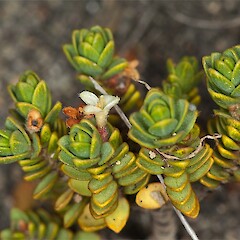Pimelea prostrata subsp. thermalis
Common name
pinātoro
Synonyms
Pimelea rugulosa Colenso
Family
Thymelaeaceae
Flora category
Vascular – Native
Endemic taxon
Yes
Endemic genus
No
Endemic family
No
Structural class
Trees & Shrubs - Dicotyledons
Current conservation status
The conservation status of all known New Zealand vascular plant taxa at the rank of species and below were reassessed in 2017 using the New Zealand Threat Classification System (NZTCS) – more information about this can be found on the NZTCS website. This report includes a statistical summary and brief notes on changes since 2012 and replaces all previous NZTCS lists for vascular plants.
Please note, threat classifications are often suggested by authors when publications fall between NZTCS assessment periods – an interim threat classification status has not been assessed by the NZTCS panel.
- Conservation status of New Zealand indigenous vascular plants, 2017 . 2018. Peter J. de Lange, Jeremy R. Rolfe, John W. Barkla, Shannel P. Courtney, Paul D. Champion, Leon R. Perrie, Sarah M. Beadel, Kerry A. Ford, Ilse Breitwieser, Ines Schönberger, Rowan Hindmarsh-Walls, Peter B. Heenan and Kate Ladley. Department of Conservation. Source: NZTCS and licensed by DOC for reuse under the Creative Commons Attribution 4.0 International licence.
2017 | Not Threatened
Previous conservation statuses
2012 | Data Deficient
2009 | Not Threatened
2004 | Not Threatened
Brief description
Low growing shrub with many short branches on main stems bearing crowded pairs of blue-green leaves that are ridged on the underside and that join the stem at a small ridge, hairy white flowers and white fruit inhabiting north from Hawke’s Bay. Leaves 5-8mm long by 2-3mm wide.
Distribution
Endemic. North Island: North Auckland and South Auckland, including Waikato, King Country, Hauraki Plains, Bay of Plenty; Rotorua (thermal region), northern part of the Volcanic Plateau; Hawke’s Bay, mainly inland, sometimes near the coast.
Habitat
Coastal to montane. Gumlands, thermal deposits, old volcanic deposits, short grassland, shrubland.
Detailed description
A moderately large, much-branched shrub with prostrate habit. Main stems to 600 mm long, dark brown, stout and stiff or flexible. The primary lateral branches are usually long and flexible or sometimes straight and stiff. They usually bear abundant, short, secondary, very leafy laterals. Young branchlets are clad, sparsely, in short hair. Internodes 2–5 mm long, shorter on laterals. Older stems glabrous, dark brown to grey-brown. Node buttresses dark brown, extending the length of the internode, not prominent on leafless stems. Leaves ascendant then patent, on very short (0.1–0.2 mm), often dark red petioles, or sessile. Lamina narrow-elliptic or elliptic to oblong or ovate, 5–8 × 2–3 mm, medium to dull green, sometimes glaucous, slightly keeled, acute. Midvein evident abaxially, sometimes red. Leaves on secondary lateral branchlets relatively small. Inflorescences terminal on branchlets, 4–6-flowered. Involucral bracts 4, smaller than, the same size as, or larger than adjacent ordinary leaves (6.0 × 2.5 mm). Flowers white, moderately hairy outside; inside hairless. Female tube 2.2 mm long, ovary portion 2 mm, calyx lobes 1.0 × 0.8 mm; hermaphodite tube 4 mm long, ovary portion 1.8 mm, calyx lobes 2 × 1 mm. Ovary sparsely hairy at summit. Fruits ovoid, white, opaque 5 × 3 mm. Seeds 2.7 × 1.5 mm.
Similar taxa
Plants of the Pimelea prostrata complex are distinguished by the prostrate to decumbent growth habit; by the glabrous to sparse or moderate hair covering on young stem internodes and by the thin and pliable, completely glabrous leaves with stomata clearly visible on both leaf surfaces. Pimelea prostrata subsp. thermalis is distinguished from subsp. prostrata, subsp. seismica, subsp. ventosa and subsp. vulcanica by the node buttresses elongate to covering the entire internode length; prominent, secondary lateral branches and by the true leaves which are slightly keeled, up to 8.0 × 2–3 mm and which have acute apices
Flowering
September - May
Flower colours
White
Fruiting
October - July
Propagation technique
Easily grown from semi-hardwood cuttings and rooted pieces. Seed is difficult to germinate. Best grown in a well drained soil in full sun. An excellent plant for the rockery.
Threats
Burrows (2009) states that this subspecies was formerly widespread in North and South Auckland but that it has declined from these areas and that it would require management to stop further losses. However, hard data to substantiate these claims was not presented, as such this subspecies would probably merit listing as Data Deficient (simply as a precautionary measure) until further information is made available.
Etymology
pimelea: Pimeleoides means “resembling Pimelea’’, a genus in the family Thymelaeaceae (Greek, -oides = resembling, like).
prostrata: Prostrate
Where To Buy
Not commercially available.
Attribution
Description from: Burrows (2009)
References and further reading
Burrows, C.J. 2009: Genus Pimelea (Thymelaeaceae) in New Zealand 2. The endemic Pimelea prostrata and Pimelea urvilliana species complexes. New Zealand Journal of Botany 47: 163–229.






